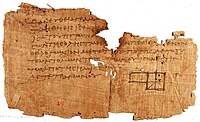
Photo from wikipedia
In contrast to existing research that has typically addressed the process from example generation to proof construction, this study aims at enhancing empirical examination after proof construction leading to revision… Click to show full abstract
In contrast to existing research that has typically addressed the process from example generation to proof construction, this study aims at enhancing empirical examination after proof construction leading to revision of statements and proofs in secondary school geometry. The term “empirical examination” refers to the use of examples or diagrams to investigate whether a statement is true or a proof is valid. Although empirical examination after proof construction is significant in school mathematics in terms of cultivating students’ critical thinking and achieving authentic mathematical practice, how this activity can be fostered remains unclear. This paper shows the strength of a particular kind of mathematical task, proof problems with diagrams, and teachers’ roles in implementing the tasks, by analysing two classroom-based interventions with students in the eighth and ninth grades. In the interventions, the tasks and the teachers’ actions successfully prompted the students to discover a case rejecting a proof and a case refuting a statement, modify the proof, properly restrict the domain of the statement by disclosing its hidden condition, and invent a more general statement that was true even for the refutation of the original statement.
Journal Title: Educational Studies in Mathematics
Year Published: 2017
Link to full text (if available)
Share on Social Media: Sign Up to like & get
recommendations!